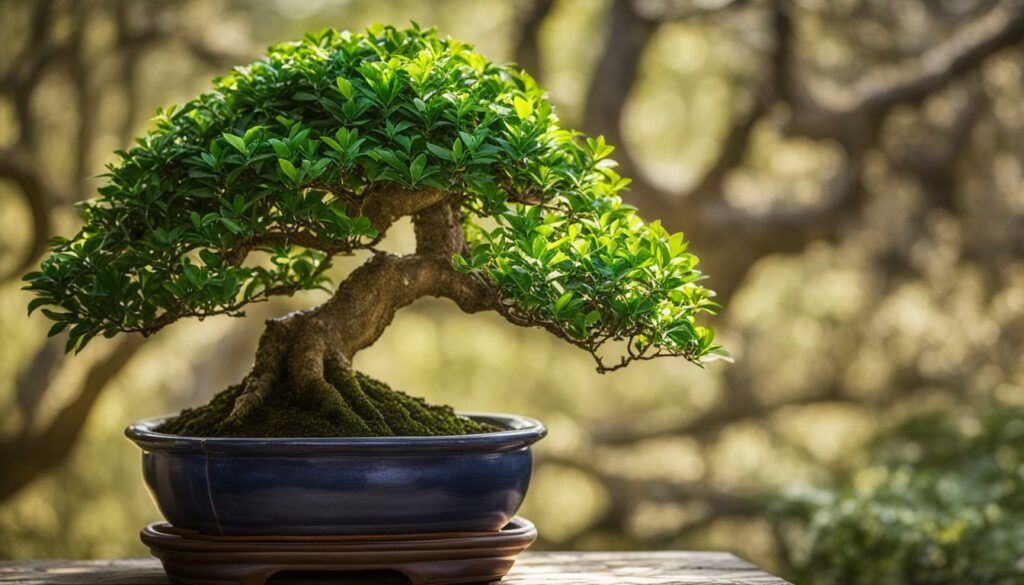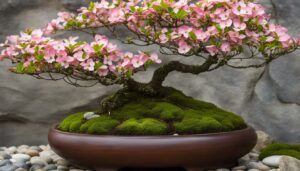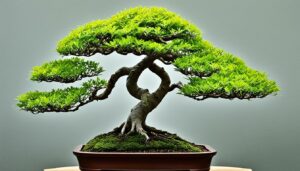Are you ready to explore the world of Bonsai Tree Species Ligustrum? Whether you’re a seasoned bonsai enthusiast or a beginner, you’ll enjoy cultivating this hardy and beautiful species. With its interesting history and unique features, Ligustrum bonsai is a popular choice for outdoor enthusiasts and indoor gardeners alike. In this comprehensive guide, you’ll discover everything you need to know about caring for your Ligustrum bonsai and creating magnificent bonsai designs.
Key Takeaways
- Ligustrum bonsai is a hardy species that can thrive in both indoor and outdoor environments.
- Proper watering, fertilizing, and soil mix are essential for maintaining a healthy Ligustrum bonsai.
- Shaping and styling Ligustrum bonsai requires careful pruning and wiring techniques to achieve the desired aesthetic.
- Pests and diseases can threaten the health of Ligustrum bonsai, so regular monitoring is crucial.
- Displaying and maintaining a Ligustrum bonsai requires positioning, watering, and ongoing maintenance.
About the Ligustrum Bonsai
The Ligustrum bonsai is a popular choice amongst bonsai enthusiasts for its distinct features and historical significance. This species is a member of the olive family and originated in China and Japan. Throughout history, it has been used for its medicinal properties and in religious ceremonies.
The Ligustrum bonsai is known for its long, narrow leaves, and delicate white flowers that bloom in late spring. During the autumn, the tree produces small, blue-black fruits.
One of the advantages of the Ligustrum bonsai is its hardiness, making it an ideal choice for beginners or outdoor bonsai enthusiasts. With proper care, the tree can flourish for decades and mature into a beautiful, ancient-looking specimen.
“The Ligustrum bonsai is a graceful and elegant tree that is perfect for many different design styles, including formal, informal, or even windswept.”
Whether you are a seasoned bonsai enthusiast or just starting, the Ligustrum bonsai is an excellent choice for its beauty, resilience, and longevity.
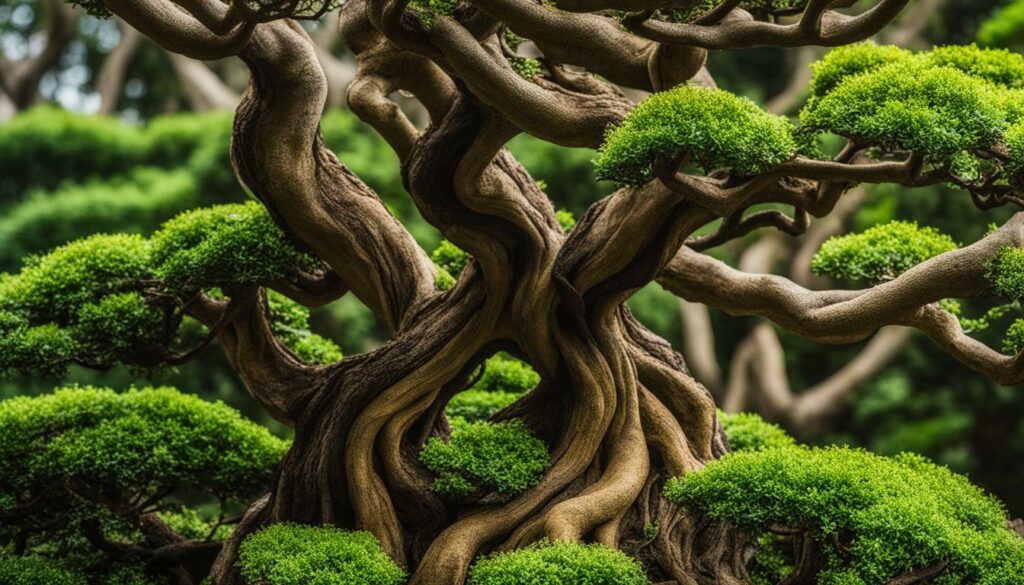
Ligustrum Bonsai Care Basics
As with any bonsai tree, proper care is critical to ensure a healthy and thriving Ligustrum bonsai. Here are the fundamental care requirements to help you get started:
Ideal Growing Conditions
Ligustrum bonsai thrives in outdoor environments with plenty of sunlight and good air circulation. Choose a spot that receives at least six hours of direct sunlight each day and avoid placing your bonsai near air conditioners, heaters, or other sources of temperature fluctuations.
| Growing Conditions | Details |
|---|---|
| Sunlight | At least 6 hours of direct sunlight daily |
| Temperature | Avoid extreme temperature fluctuations |
| Air Circulation | Provide good air circulation |
| Humidity | 50-60% humidity is ideal |
For optimal growth, humidity levels between 50-60% are necessary. If you live in a dry area, consider misting your bonsai regularly or using a humidity tray to maintain the ideal levels.
Watering Routine
Proper watering is crucial for your Ligustrum bonsai’s well-being. Water your bonsai when the soil dries out partially, but do not let the soil dry out completely. Be mindful not to overwater, as Ligustrum bonsai is susceptible to root rot. Check the soil’s moisture level regularly to establish a consistent watering schedule.
Essential Tips for Fertilizing
A well-fertilized Ligustrum bonsai grows healthy and strong. Fertilize your bonsai during the growing season, usually from early spring to late summer, with a balanced, slow-release fertilizer. Avoid fertilizing during the winter months when your bonsai is dormant. Be mindful not to apply too much fertilizer, which can burn your bonsai tree.
Image
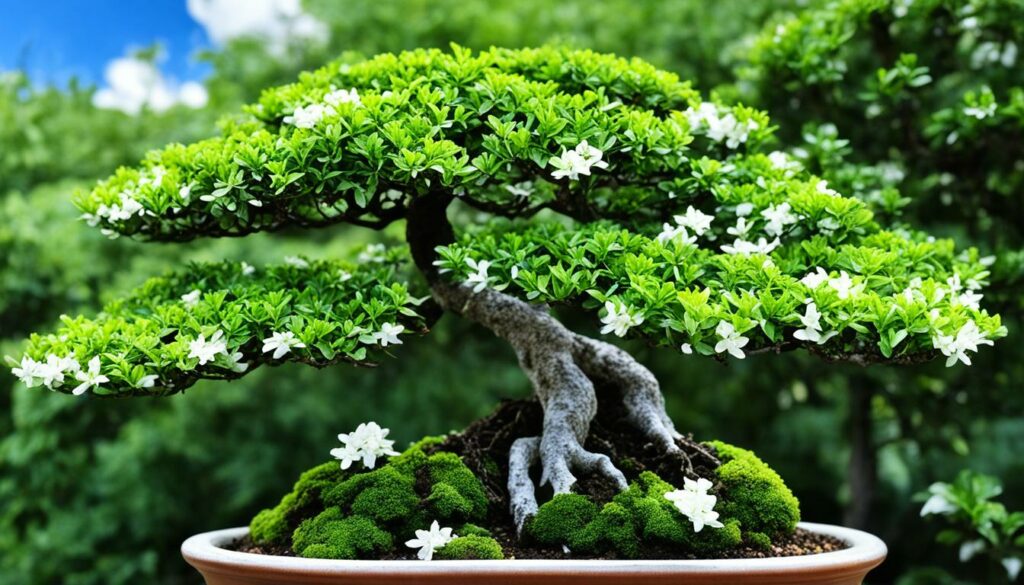
Shaping and Styling Ligustrum Bonsai
Shaping and styling your Ligustrum bonsai is where your creativity can flourish. There are several techniques you can use to create beautiful and captivating designs. Here are some tips to help you get started:
- Pruning: Regular pruning helps to maintain the shape and size of your Ligustrum bonsai. Use sharp shears to cut back branches to your desired size and shape. Focus on removing any weak or damaged branches.
- Wiring: Wiring helps to manipulate the trunk and branches of your bonsai into the desired shape. Wrap the wire around the branch and gently apply pressure in the desired direction. Remember to check the wire regularly to avoid damaging the bark.
- Bonsai Styles: There are several bonsai styles you can achieve with Ligustrum, including formal upright, informal upright, slanting, semi-cascade, and cascade. Research each style to determine which one you want to achieve, and then shape your bonsai accordingly.
In addition to these tips, it’s important to keep your bonsai’s natural growth pattern in mind when shaping it. Ligustrum bonsai are very forgiving and can tolerate a significant amount of pruning and wiring.
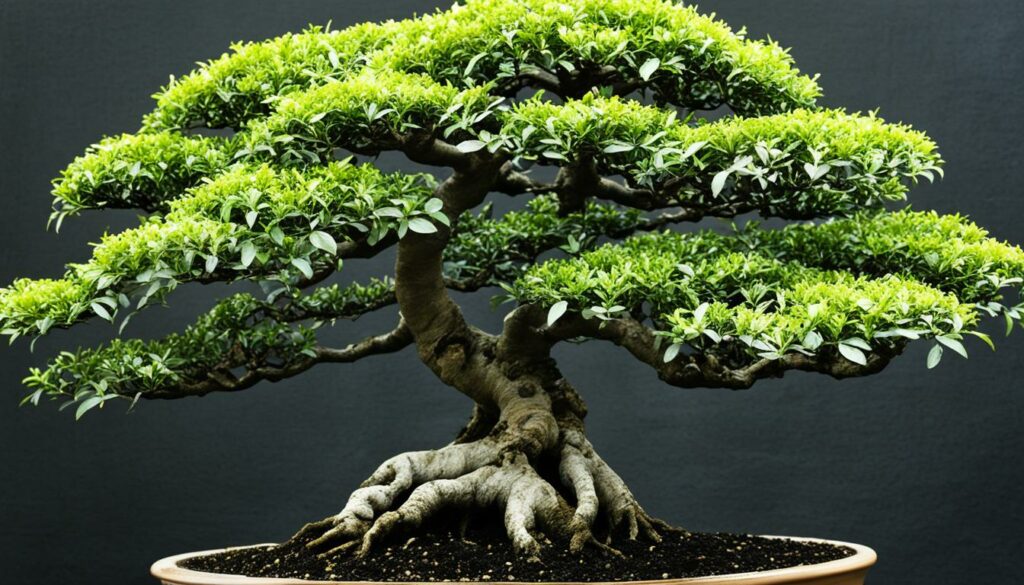
“The challenge of bonsai is to create art within the confines of nature.” – Unknown
Pests and Diseases to Watch Out For
Despite the Ligustrum bonsai’s resilience, it is still prone to pests and diseases that can damage its health and appearance. By learning how to identify, prevent, and treat these issues, you can ensure the longevity and vitality of your outdoor bonsai.
Common Pests
The most common pests that can affect Ligustrum bonsai include:
| Pest | Description | Treatment |
|---|---|---|
| Scale insects | Tiny, oval-shaped insects that suck the sap from the plant and cause yellowing leaves and stunted growth. | Remove by hand or with a soft brush and apply insecticidal soap or oil. |
| Aphids | Small, green or brown insects that feed on the plant’s foliage and excrete a sticky substance known as honeydew. | Use a strong stream of water to dislodge the insects, or apply insecticidal soap or oil. |
| Spider mites | Small, reddish-brown arachnids that spin webs and cause yellowing leaves and overall decline of the plant. | Apply insecticidal soap or oil, or release predatory mites to control the infestation. |
Regularly inspecting your Ligustrum bonsai and addressing any pest issues promptly can prevent the spread of infestations and maintain the health of your tree.
Common Diseases
The most common diseases that can affect Ligustrum bonsai include:
| Disease | Description | Treatment |
|---|---|---|
| Anthracnose | A fungal disease that causes dark spots on leaves, premature defoliation, and stunted growth. | Remove affected leaves and prune affected branches. Apply a fungicide to prevent further spread. |
| Root rot | A fungal disease that causes roots to rot and inhibits the plant’s ability to absorb water and nutrients. | Improve drainage and avoid overwatering. Use a fungicide to treat the affected roots. |
Preventing disease in Ligustrum bonsai involves providing proper care, including appropriate watering, pruning, and fertilizing techniques, as well as promptly addressing any signs of disease.
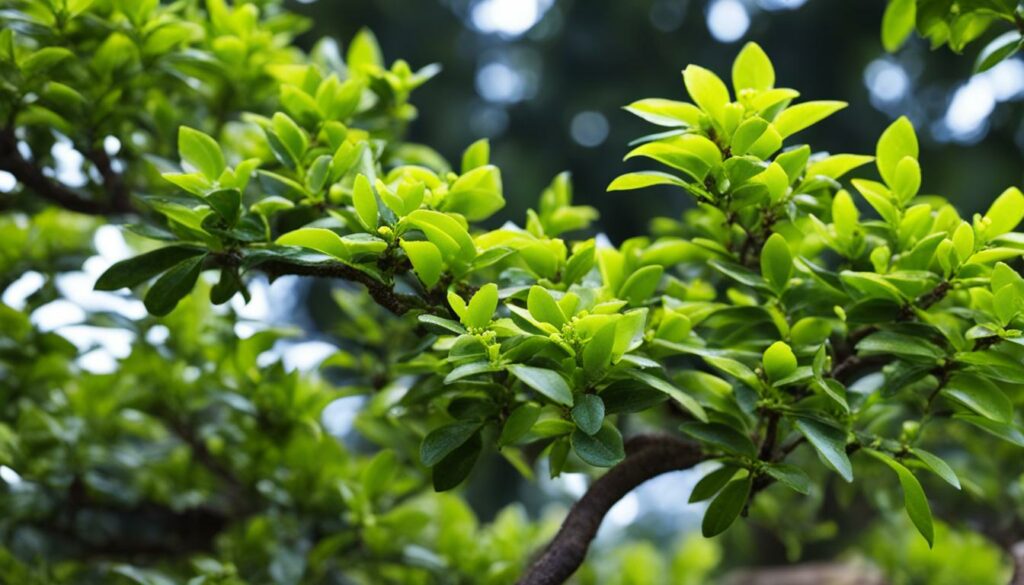
By remaining vigilant and proactive in your Ligustrum care, you can keep your outdoor bonsai thriving and flourishing.
Ligustrum Bonsai Outdoor Care Guide
If you’ve opted for an outdoor Ligustrum bonsai, it’s essential to provide the best environment for its growth. Here are some care tips to keep in mind:
Seasonal Considerations
Ligustrum bonsai thrive in warm and sunny conditions, so make sure to place them in a spot that receives ample sunlight. However, during extreme heatwaves or droughts, it’s important to provide shade or mist the foliage to prevent dehydration. During winter, protect your bonsai from harsh winds and frost, either by bringing it indoors or wrapping it in burlap or other winter coverings.
Watering
The watering needs of an outdoor Ligustrum bonsai will vary depending on the season and climate. During hot and dry periods, water your bonsai every day or every other day, depending on how quickly the soil dries out. In cooler months, reduce the frequency but keep the soil slightly moist at all times. Avoid overwatering, as this can lead to root rot and other issues.
Soil
Choose a well-draining soil mix that’s rich in organic matter, such as compost or peat moss. Avoid using regular garden soil, as it can become too compact and suffocate the roots. You can also add small amounts of grit or sand to improve drainage.
Pruning and Training
Regular pruning and training are crucial for maintaining the shape and size of your Ligustrum bonsai. Prune the foliage and branches during the late winter or early spring, before the growing season starts. Use wire to gently train the branches into your desired shape, but be careful not to bend them too harshly or cause damage.
“Providing the right outdoor environment for your Ligustrum bonsai is crucial for its growth and longevity. Keep in mind the seasonal considerations, watering routine, soil, pruning, and training requirements to ensure its health and vitality.”
Follow these simple guidelines to care for your Ligustrum bonsai and enjoy its beauty for years to come.
Ligustrum Bonsai Repotting and Soil Mix
Repotting is a vital aspect of Ligustrum bonsai care as it ensures the optimal growth of your tree. Experts suggest repotting your bonsai every two to three years, preferably in early spring before new growth emerges. Regular pruning and root trimming require that the plant receives more nutrients, and repotting will provide the necessary nutrients to the tree.
To repot your Ligustrum bonsai, follow these simple steps:
- Gently remove the tree from its pot, being careful not to damage the roots.
- Using pruning shears, trim the roots to encourage growth and remove any dead or damaged roots.
- Carefully transfer the tree to a new pot that is slightly larger than the previous one, filling it with a suitable soil mix.
- Water the plant thoroughly and ensure the soil is adequately moist.
When selecting soil for your Ligustrum bonsai, choose a well-draining mix that contains a combination of organic material, such as peat moss, and inorganic matter, such as perlite or gravel. This will provide a balance of nutrients, drainage, and moisture retention that is essential to the growth and long-term health of your tree.
Remember to monitor your bonsai closely after repotting, adjusting its growing conditions and care as necessary to ensure it continues to thrive.
Ligustrum Bonsai Display and Maintenance
Once you’ve properly cared for your Ligustrum bonsai, it’s time to display and maintain it to keep it healthy and thriving. Here are some essential practices that will help you achieve an attractive and healthy bonsai tree all year round:
Positioning
When it comes to displaying your Ligustrum bonsai, it’s important to position it in a way that showcases its beauty and reflects its natural environment. Ideally, place it in a location that receives plenty of sunshine and adequate air circulation to maintain optimal health. Moreover, make sure to avoid exposing it to extreme weather conditions that could damage it.
Watering
Consistent watering is essential for your Ligustrum bonsai to thrive. Regularly check the soil for moisture levels and water it as needed, being careful not to overwater it or let it dry out. Additionally, use a watering can or a misting sprayer to water the leaves and needles of your bonsai tree, ensuring it stays hydrated and healthy.
Pruning and Trimming
Regular pruning and trimming of your Ligustrum bonsai is vital in maintaining its shape and preventing it from becoming overgrown. Use sharp, clean bonsai scissors to trim back new branches and remove any dead or damaged foliage. This will not only keep your tree looking its best but also encourage new growth.
Regular Maintenance
Performing regular maintenance tasks is crucial in keeping your Ligustrum bonsai in top shape. This includes removing any weeds or debris from the soil, checking for pests or diseases, and applying fertilizer during the growing season. By consistently investing time and attention to your bonsai tree, you’ll enjoy its beauty and longevity for years to come.
Ligustrum Bonsai Tips for Beginners
Congratulations on embarking on the journey of growing your Ligustrum bonsai! Starting out can be overwhelming, but with these essential tips, you’ll be well on your way to cultivating a thriving tree.
Choose the Right Location
When selecting a spot for your Ligustrum bonsai, keep in mind that these trees prefer outdoor environments with plenty of natural light and good air circulation. Avoid positioning your bonsai in direct sunlight or harsh, windy areas to prevent drying out the soil too quickly or damaging its delicate foliage.
Tip: Aim to place your Ligustrum bonsai somewhere it can receive consistent, bright light throughout the day, such as near a sunny window, balcony, or backyard.
Master the Watering Routine
Watering your Ligustrum bonsai is a crucial aspect of its care routine, but it’s essential not to overdo it. Overwatering can lead to root rot, while under-watering will leave the foliage dry and withered. As a beginner, it can be tricky to find a balance, so pay attention to your tree’s needs and watering frequency.
Tip: Check the soil’s moisture level by inserting your finger into the soil up to the first knuckle. If the soil feels dry, it’s time to water.
Start with Basic Shaping Techniques
Shaping and styling your Ligustrum bonsai is a significant part of its aesthetic appeal, but it’s best to start with basic techniques before attempting complex designs. Begin by pruning the tree’s branches and foliage to achieve a symmetrical shape, using sharp, clean tools to prevent damage to the tree.
Tip: Don’t be afraid to remove foliage liberally from the bottom of the tree to create space for other distinctive features.
Be Patient and Consistent
Cultivating a thriving Ligustrum bonsai takes time and dedication, so be prepared to invest both consistently. Give your tree the time it needs to grow and mature, and keep up with its essential care routines to ensure it stays healthy.
Tip: Lend your tree a little extra love and attention by talking to it or playing classical music. Studies have shown that these practices help cultivate healthy growth in plants.
Conclusion
Congratulations on completing your deep dive into the world of the Ligustrum bonsai, one of the hardiest and most popular outdoor bonsai species.
Remember that proper Ligustrum care is essential for the health and longevity of your tree. This includes providing it with ideal growing conditions, regular watering, and suitable fertilization.
Shaping and styling your Ligustrum bonsai can be an enjoyable and creative experience. Utilizing pruning techniques and wiring methods can help you achieve different styles and designs.
Keep an eye out for common pests and diseases that may affect your Ligustrum bonsai, and promptly identify and treat any issues to ensure its continued vitality.
As you continue to care for your Ligustrum bonsai, don’t forget to consider seasonal considerations, proper positioning, and regular maintenance to keep it looking its best.
Thank you for taking the time to learn about this fascinating bonsai species. With ongoing care and dedication, your Ligustrum bonsai can bring beauty and enjoyment to your outdoor space for years to come.
FAQ
What is Ligustrum bonsai?
Ligustrum bonsai refers to a bonsai tree that belongs to the Ligustrum species. It is a popular choice among bonsai enthusiasts due to its beautiful appearance and resilience.
How do I care for a Ligustrum bonsai?
To care for a Ligustrum bonsai, provide it with a well-draining soil mix, water it regularly, and place it in a location with sufficient sunlight. Prune and shape the tree as needed, and protect it from extreme weather conditions.
Can I grow a Ligustrum bonsai outdoors?
Yes, Ligustrum bonsai can be grown outdoors. They thrive in outdoor environments with adequate sunlight and proper care. However, it is important to protect the tree from extreme weather conditions.
How often should I water my Ligustrum bonsai?
The frequency of watering your Ligustrum bonsai depends on various factors such as climate, season, and pot size. Generally, it is recommended to check the moisture level of the soil and water the tree when the top inch of soil feels dry.
What are common pests and diseases that affect Ligustrum bonsai?
Ligustrum bonsai can be susceptible to pests such as aphids, scale insects, and spider mites. Diseases like powdery mildew and root rot can also affect them. Regularly inspect your bonsai tree and take appropriate measures to prevent or treat any infestations or diseases.
When should I repot my Ligustrum bonsai?
Ligustrum bonsai should be repotted every two to three years or when the root system becomes overcrowded. The ideal time for repotting is during the early spring before new growth begins.
How should I style and shape my Ligustrum bonsai?
Styling and shaping Ligustrum bonsai can be done through pruning and wiring techniques. Regular pruning helps maintain the desired shape, while wiring allows you to position and shape the branches. Always use proper tools and techniques to prevent damage to the tree.
Can Ligustrum bonsai be displayed indoors?
While Ligustrum bonsai can tolerate indoor conditions for short periods, they are ideally suited for outdoor display. They require natural sunlight and proper airflow for their growth and overall health.
What are some beginner tips for caring for Ligustrum bonsai?
For beginners, it is important to research and understand the specific care requirements of Ligustrum bonsai. Start with a healthy tree, provide proper watering and sunlight, and gradually learn pruning and styling techniques. Don’t be afraid to seek guidance from experienced bonsai enthusiasts or join a local bonsai club for support.
